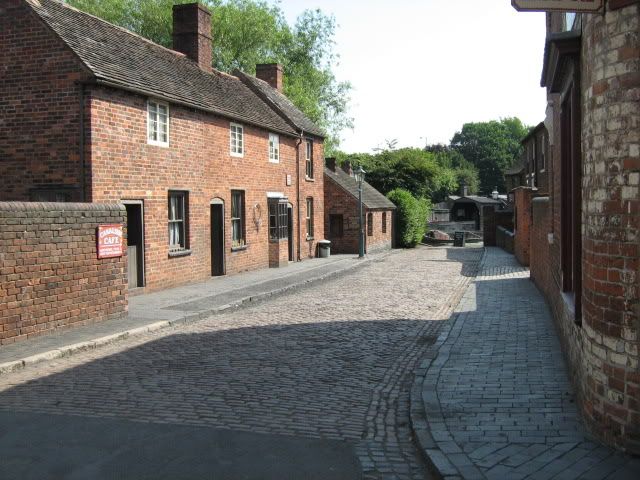Day 1: Standing Stones | Day 2: Cotswold Way | Day 3: Don't You Know There's a War On?
6/27 Sunday
Sunday was another warm sunny day, and we headed for the Black Country Living Museum. The museum is a living history museum, with various buildings from the area that have been moved to the museum grounds and preserved. Costumed interpreters man the various businesses and explain their crafts to visitors. The museum does not stick to just one period but preserves both Victorian and later periods—their newest street is filled with businesses contemporary to the 1930s.

There doesn't seem to be a lot of agreement as to which parts of the country are 'the Black Country' and which aren't- though they do say that a native knows it when he sees it! We'd had some acquaintance with the history, but seeing the places made a difference, though it wasn’t exactly true to the history- it was missing the smog of coal dust that so darkened the skies in early industrial days that the street lights were lit night and day. Truly, we weren’t sorry to miss that part.
We took a canal boat ride into a limestone mine—it was startling, both for the extent of the tunnels—there were miles of them—and for the size of the mine. There was a great deal more of it than our tour covered and even the parts we saw were quite impressive. After long stretches of tunnel, we’d break out into grottos where several tunnels intersected, letting fresh air and light down into the tunnel system.


The tunnels were too narrow for a towpath, so when the boats were hauled up to the tunnel the horses would be unhitched. The more experienced ones would plod around to the other side of the tunnel and wait for their boat to come out. In the meantime, the boat would be propelled through the tunnel by ‘legging’—two men would brace against each others’ shoulders with their feet against the tunnel wall and walk the boat through the tunnel.

After the canal boat ride, we had some excellent fish and chips at the chip shop, and washed it down with ginger beer (which the pub had on tap- *awesome*!) and wandered around watching various demonstrations. We saw a man making chain by hand:

...then wandered through the schoolhouse and visited the Cradley Heath Worker’s Institute, a social and industrial center built in 1912, which was preserved and moved to the museum in 2006.
We were in particular struck by the story of Mary Macarthur, an early labor organizer, and the strike of the women chain makers. Chain was in high demand at the time for all sorts of applications, and the finer gauges were almost exclusively made by women and children on home forges. Chain makers were paid by weight, not by the number of links, so women made much longer chains for the weight, and were paid a pittance. The strike was particularly notable for its use of mass media to call attention to a social condition. In addition to newspapers, the working conditions of the women were publicized in a film only two months after the first British newsreel was shown, and eventually resulted in more than doubling the women’s salaries as well paving the way for the eventual passage of a national minimum wage in Britain.
We also took a walk down a coal mine- which was quite different to an American mine we'd toured in Pennsylvania-- much closer to the surface, and mining soft coal, not hard. Hard, dirty, dangerous and badly paid summed up many of the jobs then, and yet the industrial revolution was born from their labor.
The very first steam engine, the Newcomen engine, was built in the Black Country, and they had a replica. A Victorian observatory is under construction. Many old vehicles are preserved, including the trolleys (trams, in British) that shuttle visitors from one end of the museum to the other. They had a builder’s yard, with various stonework, and a draper’s shop; a coalyard and a mine office. We learned from the clerk at the gentleman’s outfitters’ that attaching collars to shirts was a newfangled American idea, brought over by troops during the Second World War.
There were several iron houses (a fad that never really caught on), and examples of a dizzying variety of iron products made in the area. Take a close look at this one- a display of local products (you can click to enlarge it).

We finished the day in the museum/visitor center, which had various displays, along with films and recordings of people talking about their lives in prior days.
Slideshow of more Black Country Living Museum photos: (You can click on the show to see it with larger photos.)



Great pics! My fav so far ('cause it's so unexpected, I expect) is the one of the fellows shoulder to shoulder, working the boat through the tunnel. So cool!
ReplyDeleteWow. Just, wow.
ReplyDeleteThis is so great!!! Wonderful pictures!!!!
ReplyDelete